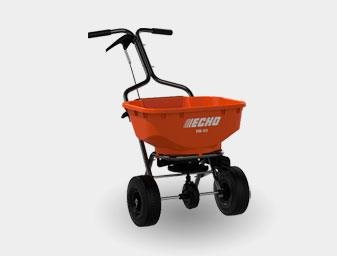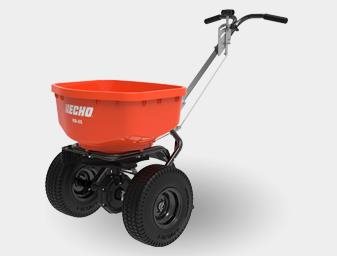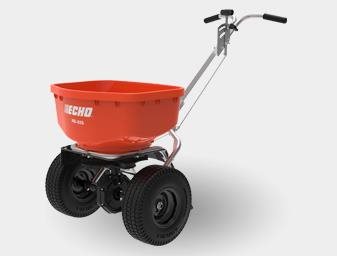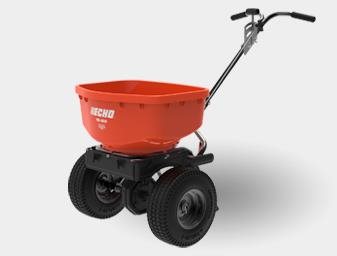How to Fertilize Your Lawn
Having a lawn the whole block is envious of doesn’t happen by accident. Every vibrant green yard has a Yarder or professional landscaper who provides consistent, quality care. Fertilization is at the top of the list when it comes to lawn health. Fertilizing your yard strengthens grass root systems to promote rich, full growth. Fertilizer helps your grass recover from stress, fight weeds, and stay lush all season long.
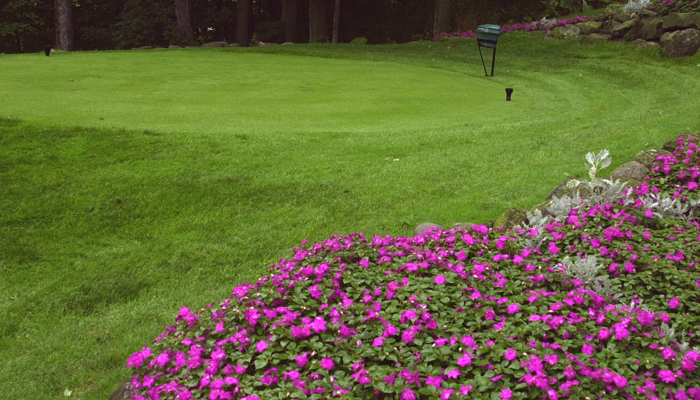
Once you learn how to spread fertilizer on your lawn, you’ll see it’s simple and worth the effort. A well-fed and fertilized lawn is more drought-resistant and can fight off disease, so the time you put in means less work in the long run and a more beautiful yard. The best tool for fertilizing a yard is a broadcast spreader. They make the job quick and even, ensuring your grass gets the nutrients it needs without waste or patchiness. ECHO spreaders do more than just fertilize, though. They can be used for overseeding, applying ice melt, or spreading granular herbicides. Experienced Yarders and landscaping pros know a quality spreader is one of the most valuable tools to keep on hand.
Keep reading to learn how to fertilize your lawn and the steps to use to get the job done right every time.
When to Fertilize Your Lawn
When it comes to fertilizing, timing is everything. The type of grass you have determines which nutrients are necessary during which stages of the growth cycle. Understanding when your lawn is actively growing is key to your fertilizing schedule.
Cool-season grasses: Fescue, rye grass, and bluegrass all thrive in the spring and fall seasons during moderate to cool temperatures. Fertilizing at the right time supports strong growth in cold-weather conditions. Feeding strategically builds reserves so your lawn can survive the harsh winter months and unpredictable spring weather.
Warm-season grasses: Bermuda, Zoysia, and St. Augustine grasses thrive in the heat of late spring and summer. If you fertilize your yard too early, when these grasses are still dormant, you risk wasting the nutrients. Wait until your lawn starts to green up in late spring before applying the first layer of fertilizer.
Most lawns need fertilization at least twice a year. A good rule of thumb is to kick-start growth in the spring and then fertilize again in the fall to strengthen roots before your grass enters dormancy.
Preparing Your Lawn For Fertilization
A little preparation goes a long way toward getting the best fertilization results. For best results, start your project by mowing your grass to a moderate height. Clear away any yard debris, such as sticks or leaves, so the fertilizer granules can make direct contact with the soil instead of resting on the grass.
Conduct a simple soil test to determine your yard’s pH and nutrient levels. Testing the soil tells you what fertilizer blend you should apply to address your lawn’s specific needs.
Don’t forget to water your lawn one to two days before you fertilize. Moist soil absorbs nutrients more efficiently. To prevent runoff and waste, though, don’t fertilize immediately after a very heavy rainfall.
Steps to Fertilize Your Lawn
Once you’re ready, follow these steps to fertilize your lawn. Each one ensures you get the most even coverage and optimal results.
Identify Your Grass Type & Choose the Right Fertilizer
Not all grasses need the same nutrients at the same time of year. For example, cool-season grass needs a fertilizer that’s higher in nitrogen. Warm-season lawns generally want a more balanced blend during peak growth periods. Look at a fertilizer’s nitrogen, phosphorus, potassium (N-P-K) ratio, and choose one that’s best suited for your exact lawn type and soil needs.
Calculate Lawn Size and Fertilizer Amount
Fertilizing is based on square footage, so knowing your total lawn size is critical. Measure your yard dimensions manually or use an online mapping tool to calculate how much fertilizer you’ll need. Review the fertilizer instructions to apply the correct amount of fertilizer. If you spread grass fertilizer too lightly, your lawn won’t get enough of what it needs. Too much, however, can damage your yard or lead to nutrient runoff.
Load the Broadcaster Spreader
There are several types of spreaders to choose from, including handheld, drop spreaders, and broadcast spreaders. Most Yarders prefer broadcast spreaders because they distribute materials in broad, even arcs. This lets you cover more ground in less time, making the job easier, more thorough, and more consistent. ECHO’s line of professional-grade broadcast spreaders is excellent for all seasons and applications.
Before filling, prevent over-applying by adjusting the settings according to the manufacturer’s instructions for the fertilizer you choose. Then, carefully pour the fertilizer into the hopper on a flat surface to avoid spilling. 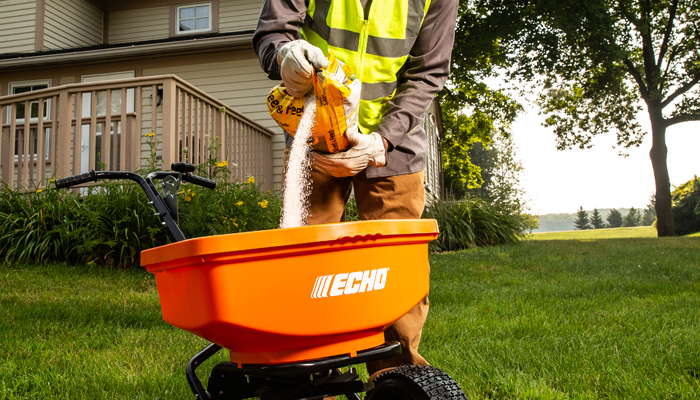
Feed the Perimeter First
Apply fertilizer to grass by outlining the perimeter of your lawn first. This is known as a boundary pass, and it keeps you from accidentally missing the edges or spilling fertilizer onto sidewalks or driveways. Walk at a steady pace and maintain a consistent pattern to get the most even coverage.
Fill in the Middle in Overlapping Rows
Once you’ve completed the boundary pass, cover the remaining area using back-and-forth, straight, overlapping rows similar to your mowing pattern. By overlapping slightly, you prevent bare spots and avoid over-applying. Make sure you walk at a consistent speed the entire time and that you keep the spreader moving when the handle is engaged for an even application across the whole yard.
Post Fertilization Care
After you’ve fed your lawn, the next 24 to 48 hours are important. Water your grass lightly so the fertilizer soaks into the soil. Avoid heavy watering, as it can wash away the fertilizer before the soil absorbs it.
Leave your lawn undisturbed for at least one full day after fertilizing. Minimize foot traffic, and if you’ve recently overseeded, give the new seed time to settle before mowing. Be patient—allowing nutrients time to work results in fuller, greener growth.
Ongoing Maintenance Tips
After you’ve fed your lawn, the next 24 to 48 hours are important. Water your grass lightly so the fertilizer soaks into the soil. Avoid heavy watering, as it can wash away the fertilizer before the soil absorbs it.
Fertilizing is essential to your lawn’s health, but it’s just one part of having a gorgeous lawn year-round. To keep your yard thriving, consistency is key. Use the following tips to help.
- Create and stick to a schedule: An annual feeding routine and lawn maintenance schedule should be tailored to your grass type.
- Mow regularly: Keep grass at the right height for its variety. Avoid cutting more than 1/3 of the blade at a time.
- Water deeply: Lawns do best with deep irrigation a couple of times a week. Avoid frequent, shallow watering.
- Reseed bare spots: Overseeding helps you maintain a thick turf look while crowding out weeds.
- Adjust lawn care by season: Different seasons need different lawn care. Make sure to pay attention and do what’s necessary during warm summers, cool falls, and wet springs.
Understanding your grass type and applying fertilizer to grass at the right time is crucial. A little bit of prep and know-how sets your yard up for lasting success. With the right tools and schedule, a healthy, green lawn is always within reach.
ECHO broadcast spreaders make fertilization efficient and as precise as possible. Spend less time guessing and more time enjoying your yard with routine, ongoing care, and tools that keep your lawn strong and beautiful all year. Get your ECHO broadcast spreader today.
